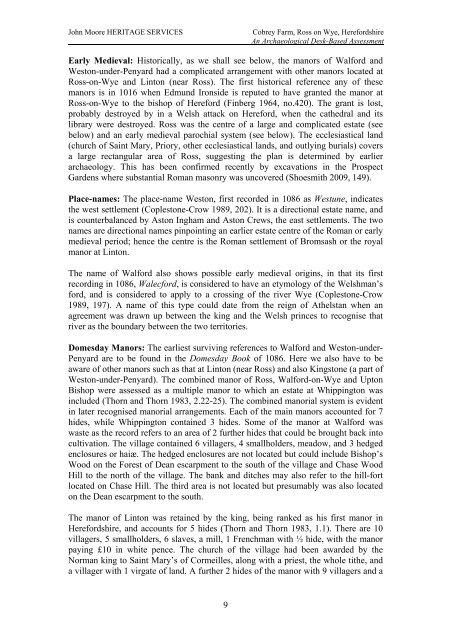JOHN MOOREHERITAGE SERVICES - Archaeology Data Service
JOHN MOOREHERITAGE SERVICES - Archaeology Data Service
JOHN MOOREHERITAGE SERVICES - Archaeology Data Service
Create successful ePaper yourself
Turn your PDF publications into a flip-book with our unique Google optimized e-Paper software.
John Moore HERITAGE <strong>SERVICES</strong> Cobrey Farm, Ross on Wye, Herefordshire<br />
An Archaeological Desk-Based Assessment<br />
Historically, as we shall see below, the manors of Walford and<br />
Weston-under-Penyard had a complicated arrangement with other manors located at<br />
Ross-on-Wye and Linton (near Ross). The first historical reference any of these<br />
manors is in 1016 when Edmund Ironside is reputed to have granted the manor at<br />
Ross-on-Wye to the bishop of Hereford (Finberg 1964, no.420). The grant is lost,<br />
probably destroyed by in a Welsh attack on Hereford, when the cathedral and its<br />
library were destroyed. Ross was the centre of a large and complicated estate (see<br />
below) and an early medieval parochial system (see below). The ecclesiastical land<br />
(church of Saint Mary, Priory, other ecclesiastical lands, and outlying burials) covers<br />
a large rectangular area of Ross, suggesting the plan is determined by earlier<br />
archaeology. This has been confirmed recently by excavations in the Prospect<br />
Gardens where substantial Roman masonry was uncovered (Shoesmith 2009, 149).<br />
The place-name Weston, first recorded in 1086 as Westune, indicates<br />
the west settlement (Coplestone-Crow 1989, 202). It is a directional estate name, and<br />
is counterbalanced by Aston Ingham and Aston Crews, the east settlements. The two<br />
names are directional names pinpointing an earlier estate centre of the Roman or early<br />
medieval period; hence the centre is the Roman settlement of Bromsash or the royal<br />
manor at Linton.<br />
The name of Walford also shows possible early medieval origins, in that its first<br />
recording in 1086, Walecford, is considered to have an etymology of the Welshman’s<br />
ford, and is considered to apply to a crossing of the river Wye (Coplestone-Crow<br />
1989, 197). A name of this type could date from the reign of Athelstan when an<br />
agreement was drawn up between the king and the Welsh princes to recognise that<br />
river as the boundary between the two territories.<br />
The earliest surviving references to Walford and Weston-under-<br />
Penyard are to be found in the Domesday Book of 1086. Here we also have to be<br />
aware of other manors such as that at Linton (near Ross) and also Kingstone (a part of<br />
Weston-under-Penyard). The combined manor of Ross, Walford-on-Wye and Upton<br />
Bishop were assessed as a multiple manor to which an estate at Whippington was<br />
included (Thorn and Thorn 1983, 2.22-25). The combined manorial system is evident<br />
in later recognised manorial arrangements. Each of the main manors accounted for 7<br />
hides, while Whippington contained 3 hides. Some of the manor at Walford was<br />
waste as the record refers to an area of 2 further hides that could be brought back into<br />
cultivation. The village contained 6 villagers, 4 smallholders, meadow, and 3 hedged<br />
enclosures or haiæ. The hedged enclosures are not located but could include Bishop’s<br />
Wood on the Forest of Dean escarpment to the south of the village and Chase Wood<br />
Hill to the north of the village. The bank and ditches may also refer to the hill-fort<br />
located on Chase Hill. The third area is not located but presumably was also located<br />
on the Dean escarpment to the south.<br />
The manor of Linton was retained by the king, being ranked as his first manor in<br />
Herefordshire, and accounts for 5 hides (Thorn and Thorn 1983, 1.1). There are 10<br />
villagers, 5 smallholders, 6 slaves, a mill, 1 Frenchman with ½ hide, with the manor<br />
paying £10 in white pence. The church of the village had been awarded by the<br />
Norman king to Saint Mary’s of Cormeilles, along with a priest, the whole tithe, and<br />
a villager with 1 virgate of land. A further 2 hides of the manor with 9 villagers and a<br />
9

















